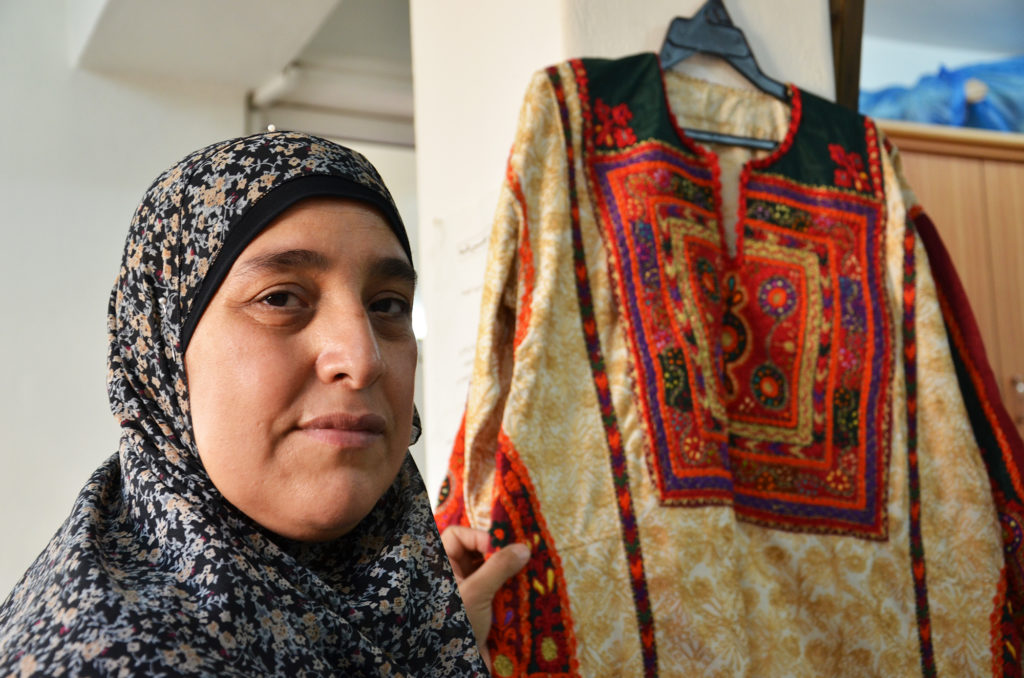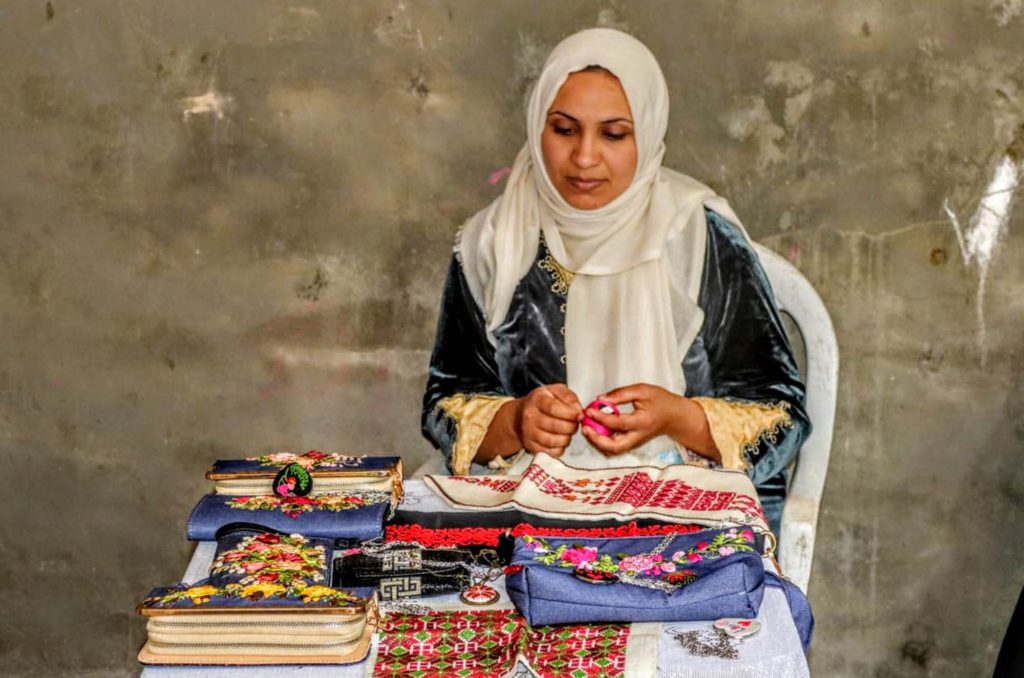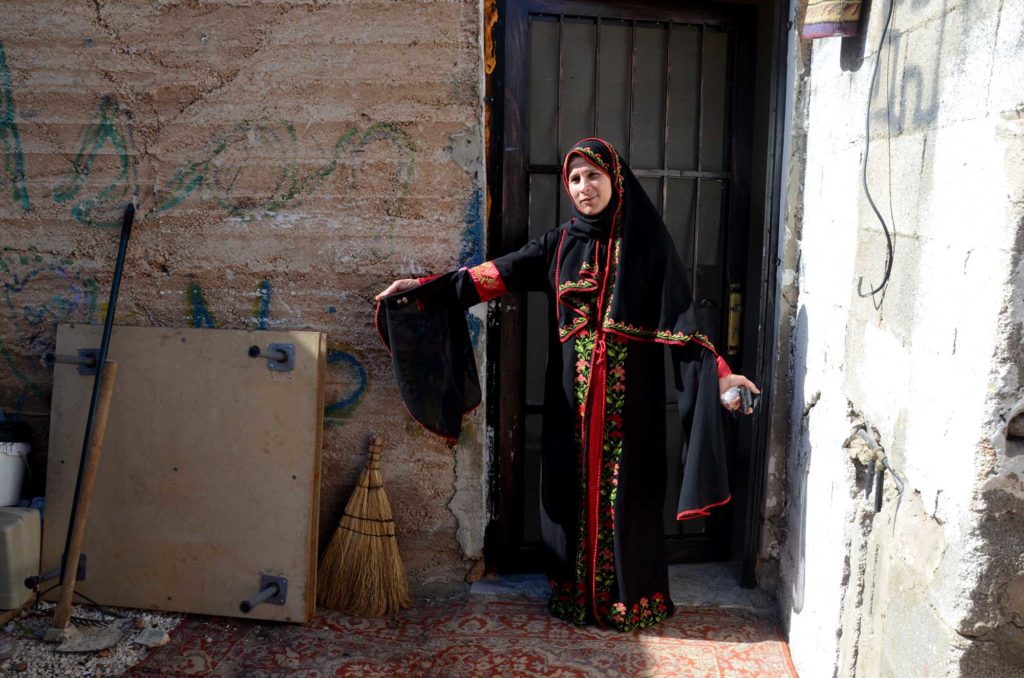Tatreez and Development
Posted in: Society & culture
A Symbol of Palestinian Culture
Tatreez is a centuries-old craft practiced primarily by Palestinian women to document their history, preserve their culture, express themselves creatively, unite as communities, and support themselves and their families. The traditional cross-stitch embroidery technique incorporates imagery that documents life in different regions of Palestine during significant times or carries on conversations between loved ones. Palestinian women also use tatreez to defy both oppressive colonial and patriarchal systems.
Tatreez is molded by circumstances and conditions in society as it is created. For example, new artistic themes emerged during the devastation of the Nakba, or “catastrophe,” in 1948 when Palestinians were forced to flee during the establishment of Israel. The resulting humanitarian crisis has affected geopolitics, individual states, the environment, and human development in the Middle East and beyond for the last seven plus decades. Tatreez also took on a new voice during the intifadas and other extraordinary moments of social and political upheaval.
Women have used the art form to take care of themselves and support their communities economically by founding businesses to sell their embroidery work. Anera has supported these development efforts by women in Palestine.
History
Palestinian women have used tatreez to express themselves for generations. They have told stories and documented their lives with needles rather than pen and paper. They have also used embroidery to teach their children about the most pressing issues of the day. The tradition has preserved Palestinian history over the years, despite displacement and destruction.
As Palestinians were expelled from their houses in 1948 and again in 1967, many women retained a tangible connection to their homes by wearing their precious tatreez thobes, a traditional dress featuring handmade embroidery designs. And, though displacement has led to some decline in the practice of tatreez, women have continued stitching through times of uncertainty. The thobes Palestinian women create now can be quite inventive since often women have had to make do with what is on hand in places of scarcity, like refugee camps.
There also has been an increase in those practicing tatreez in the Palestinian diaspora. Women are taking the traditional embroidery and making it their own – which is reflective of the Palestinian experience.
Tatreez has transformed into a movement, a collective example of Palestinians refusing to forget their past or be forgotten. Women are now stitching more contemporary pieces, not just traditional thobes, and adapting imagery that reflects the lives of those in the diaspora.


Resilience
Preserving history through embroidery is a beautiful means for women to tell their stories and express resilience. Tatreez represents their traditions before their way of life was threatened, and the continued practice of tatreez ensures that Palestinian culture is still vibrant and thriving despite challenges. Even for those physically separated from their homeland, tatreez is a powerful means of connection to home, ancestors, and the past.
Roots in Palestine are strong. Practicing tatreez and wearing any traditional Palestinian embroidery expresses resistance to erasure and proudly displays history through every stitch. By continuing to practice their craft, Palestinian women reject attempts to erase Palestinian history and culture. They practice resistance through art.
During the First Intifada, Israeli authorities banned the display of Palestinian flags and wearing the colors of the flag publicly. Palestinians, for instance, would use symbols like watermelons, which contained red, green, and black, as acts of resistance. Women responded creatively to these restrictions by embroidering symbols of nationalism into their garments — and thus, the intifada dress was born. These dresses were stitched with the Palestinian flag, maps of Palestine, and phrases such as “we will return,” woven in traditional Palestinian colors. The intifada dress was advantageous to public demonstrators because Israeli soldiers could not confiscate it as easily as flags. The intifada dress became a potent example of Palestinian women’s political agency and defiance of Israeli occupation. Also, as women adorned their bodies with these thobes, they simultaneously defied patriarchal norms. The dress declared that the woman’s body itself was an act of resistance, not just as the mother of soldiers. Women quickly and brilliantly found a way to resist both colonial and patriarchal structures through tatreez and have forever given Palestine a dress of freedom.
Development
Whether women sell their work or teach tatreez to others, there are many instances of women heads of household providing for themselves and their families through tatreez – even creating entire businesses. In particular, tatreez is a critical practice for women to earn income in refugee camps where economic opportunities are scarce. Refugee camps in southern Lebanon, for instance, have robust cooperatives where women create and sell thobes to support their families.
In Rashidieh, the oldest refugee camp in Lebanon, about 20 women work in a collective that has become the hub of local tatreez production. All of the women have been trained by other members of the collective. The women work from home, allowing them to set their own hours and care for their families. They sell their pieces globally, providing much-needed income and spreading awareness about Palestinian culture.
Anera
When women have access to educational and economic opportunities, communities benefit as a whole. They are a powerful force in the communities Anera serves. For over four decades, Anera has partnered with local women’s groups in Lebanon and Palestine to offer job skills classes, business training and even small loans.
Anera’s Women Can program supports Palestinian women entrepreneurs with training and equipment that allow them to grow or start new businesses in Palestine. And, for some women, tatreez can be a profitable pursuit. One of the trainees, Amal, honed the embroidery skills that she first learned from her mother when she was young. She knew she had a love for the craft, but was not aware that it could provide income. She is a mother of four and the primary provider for her family. Amal now sells her tatreez and is able to make a real difference to her family’s well-being. She finds it therapeutic as well. “I forget all my worries when we are together working on embroidered pieces.” And in keeping with the longstanding tradition of passing tatreez through generations of Palestinian women, Amal has begun teaching her 10-year-old daughter, Rahaf.


In the West Bank, also through Women Can, Anera supported Asmaa, who has found success in creating tateez. When Asmaa was 15 years old, she started sewing as a hobby. Now she relies on it for her income in her small West Bank town of Beit Fourik, near Nablus. Anera provided her with a sewing machine and materials, and Anera’s business training helped her to make better use of her time and finances. She fixes women’s dresses, makes decorative trays, and creates dresses. Asmaa always looks for new designs and patterns. “Sometimes I order patterns from Jordan to keep up with fashion in other countries,” she says. One big asset to her business is Asmaa’s mother. She does gorgeous embroidery work, which Asmaa uses in new dress designs. “I want to grow and include more relatives who have crafts and embroidery talents,” Asmaa says. “I’d like to have a family business!”


Tatreez is Palestine’s Yesterday, Today and Tomorrow
Tatreez is essential to preserving Palestinian history. It is a tool for economic and social development. It is passed down from generation to generation, transformed in the diaspora, and ever-changing. Tatreez remains a voice for Palestinian women and a foundation in the resistance to colonial and patriarchal structures. It also provides Palestinian women with the social, cultural, and economic agency they have historically been denied.
The rich colors and textures of tatreez signify far more than meets the eye.
Some of our favorite places where you can buy tatreez and support Palestinian women
And learn the art of tatreez at Tatreez and Tea.
OUR BLOG
Related
In this log, Anera provides updates on unfolding war in Palestine and our response. In some cases, additional activities may be added retroactively to the daily entries as we receive additional program reporting. Questions? See our FAQ page July 10,…

